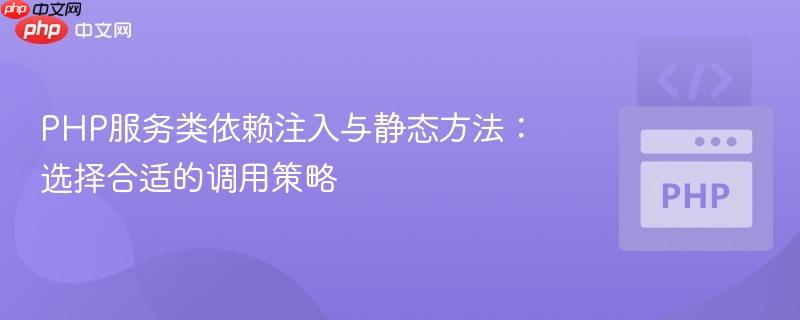
在构建复杂的php应用程序时,我们经常会遇到需要在不同服务类之间进行交互的情况。一个常见的问题是,当一个类(例如 emailservice)的构造函数需要特定的依赖项(如 entitymanagerinterface 和 emailfactory)时,如何在另一个类(例如 paymentservice)中调用它的方法,而无需直接处理这些依赖项的实例化。如果直接尝试 new emailservice(),就会遇到“too few arguments”的错误。
当一个类的构造函数被定义为接收特定参数时,PHP会强制要求在实例化该类时提供这些参数。例如,EmailService 的构造函数明确要求 EntityManagerInterface 和 EmailFactory 类型的参数:
class EmailService
{
private EntityManagerInterface $entityManager;
private EmailFactory $emailFactory;
public function __construct(EntityManagerInterface $em, EmailFactory $emailFactory)
{
$this->entityManager = $em;
$this->emailFactory = $emailFactory;
}
public function sendPaymentEmail(string $sender, User $user, string $templateKey): bool
{
// 此方法通常会使用 $this->emailFactory 来创建邮件
// 并且可能使用 $this->entityManager 来持久化邮件日志等
// 例如:
// $email = $this->emailFactory->createEmail($sender, $user->getEmail(), $templateKey);
// ... 发送邮件逻辑 ...
// $this->entityManager->persist(new EmailLog($email));
// $this->entityManager->flush();
return true;
}
}如果在 PaymentService 中尝试不带参数地实例化 EmailService,如下所示:
class PaymentService
{
// ... 其他属性和方法 ...
public function sendPaymentEmail(User $user)
{
// 错误:EmailService 构造函数需要参数
$emailService = new EmailService(); // 这里会抛出 "Too few arguments" 错误
$sender = 'no-reply@example.com'; // 假设从配置获取
return $emailService->sendPaymentEmail($sender, $user, 'customer_home');
}
}PHP解释器会因为 EmailService 的构造函数期望两个参数而实际未收到任何参数,从而抛出 TypeError: Too few arguments to function ... 错误。
解决此类问题的最佳实践是使用依赖注入 (Dependency Injection, DI)。依赖注入是一种设计模式,它将对象的依赖项从内部创建转变为外部提供。这意味着 PaymentService 不再负责创建 EmailService 实例及其依赖,而是由外部(通常是框架的服务容器或DI容器)提供一个已经准备好的 EmailService 实例。
立即学习“PHP免费学习笔记(深入)”;
依赖注入的核心思想是“反转控制”:一个对象不再控制其依赖项的创建,而是由外部容器或调用者提供这些依赖项。这使得组件之间更加解耦,提高了代码的可测试性和可维护性。
最常见的依赖注入形式是构造函数注入。在这种方法中,PaymentService 在其构造函数中声明它需要一个 EmailService 实例。
// app/src/Service/PaymentService.php
namespace App\Service;
use App\Entity\User;
use App\Service\EmailService; // 确保引入 EmailService
class PaymentService
{
private EmailService $emailService;
// 假设还有其他依赖,例如 Twig
private \Twig\Environment $twig;
// 通过构造函数注入 EmailService 实例
public function __construct(EmailService $emailService, \Twig\Environment $twig)
{
$this->emailService = $emailService;
$this->twig = $twig;
}
public function sendPaymentEmail(User $user): bool
{
$sender = $this->twig->getGlobals()['email_no_reply'] ?? 'no-reply@example.com';
// 直接使用已注入的 emailService 实例
return $this->emailService->sendPaymentEmail($sender, $user, 'customer_home');
}
}通过这种方式,PaymentService 不再关心 EmailService 内部需要哪些依赖,它只需要一个可用的 EmailService 实例。在现代PHP框架(如Symfony、Laravel)中,服务容器会自动解析并提供这些依赖。当 PaymentService 被实例化时,容器会首先实例化 EmailService(同时处理 EmailService 自身的 EntityManagerInterface 和 EmailFactory 依赖),然后将这个完整的 EmailService 实例传递给 PaymentService 的构造函数。
另一种方法是使用静态方法。静态方法不依赖于类的特定实例,可以直接通过类名调用,而无需先实例化该类。
静态方法属于类本身,而不是类的某个对象。这意味着它们不能访问类的非静态属性(即 $this 关键字在静态方法中不可用)。
静态方法适用于那些不依赖于类实例状态、纯粹的工具函数或工厂方法。例如,一个用于验证邮箱地址的函数,或者一个简单的数学计算函数。
如果 EmailService 中有一个方法,它确实不依赖于 EntityManagerInterface 或 EmailFactory,并且其功能是通用的,那么可以将其定义为静态方法。
修改 EmailService (仅为演示,请谨慎评估是否适合将 sendPaymentEmail 设为静态)
class EmailService
{
// ... 构造函数和非静态属性保持不变 ...
// 假设有一个真正不需要实例状态的工具方法
public static function isValidEmailAddress(string $email): bool
{
return filter_var($email, FILTER_VALIDATE_EMAIL) !== false;
}
// 如果 EmailService::sendPaymentEmail *真的*不需要 $this->entityManager 或 $this->emailFactory,
// 才能考虑设为静态。但通常它需要,所以这只是一个假设性示例。
// 如果它被设为静态,它将无法访问 $this->emailFactory。
// public static function sendPaymentEmail(string $sender, User $user, string $templateKey): bool
// {
// // 错误:无法访问非静态属性 $this->emailFactory
// // $email = self::emailFactory->createEmail(...);
// return true;
// }
}在 PaymentService 中调用静态方法
class PaymentService
{
// ... 构造函数和属性 ...
public function processUserEmail(string $email): string
{
if (EmailService::isValidEmailAddress($email)) { // 直接通过类名调用静态方法
return "Email address is valid.";
} else {
return "Invalid email address.";
}
}
}选择依赖注入:
选择静态方法:
在PHP中处理类方法调用和依赖管理时,理解“Too few arguments”错误背后的原因至关重要。对于服务类中需要访问实例状态和外部依赖的方法,依赖注入是解决问题的最佳实践,它能带来更好的解耦、可测试性和可维护性。而静态方法则适用于不依赖实例状态的纯工具函数,但应谨慎使用,避免滥用。选择正确的设计模式和方法,能够显著提升代码质量和项目的长期可维护性。
以上就是PHP服务类依赖注入与静态方法:选择合适的调用策略的详细内容,更多请关注php中文网其它相关文章!

PHP怎么学习?PHP怎么入门?PHP在哪学?PHP怎么学才快?不用担心,这里为大家提供了PHP速学教程(入门到精通),有需要的小伙伴保存下载就能学习啦!

Copyright 2014-2025 https://www.php.cn/ All Rights Reserved | php.cn | 湘ICP备2023035733号